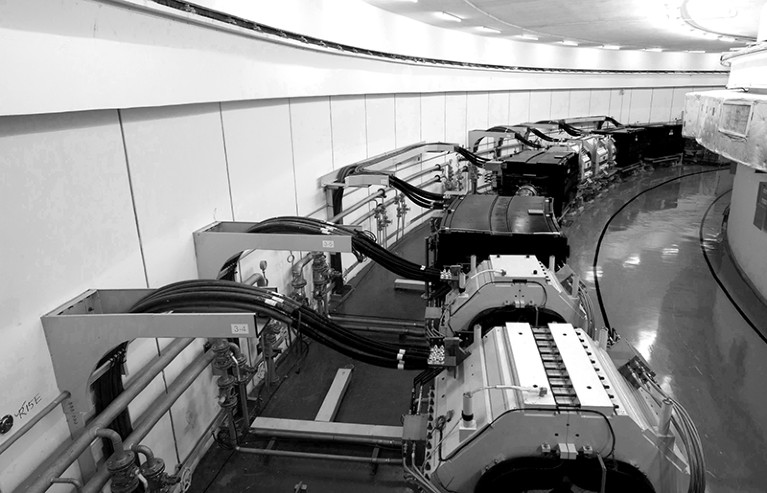
The China Spallation Neutron Source started producing neutron beamlines in August.Credit: Jin Liwang/Xinhua/ZUMA
In 2009, China opened what was at the time its costliest piece of scientific infrastructure — a 1.2-billion-yuan (US$176-million) synchrotron light source in Shanghai.
The facility put China in an elite club, and produced impressive results, such as revealing the structure of proteins that allow mammalian brain cells to get fuel from glucose, and the plumage structure of birds’ dinosaurian ancestors. More than 20,000 scientists have been involved in projects there.
But it should be doing more. When it opened, its designers promised that 30 beamlines would be feeding experiments within 5 years. Now, 8 years later, there are only 13.
Building facilities of this size and complexity brings headaches for a variety of unpredictable reasons; and the frustrations don’t end when the last door is on its hinges. For example, a deputy director at the Shanghai synchrotron told Nature that difficulties in arranging investment from various funding agencies had delayed the addition of new beamlines. (He says that this is now taken care of and that there will be 18 more beamlines over the next 5 years.)
Another scientific resource in the country, the China Advanced Research Reactor, reached criticality in 2010 and full power in 2012. But scientists have told Nature that the facility is not operating, and that specially built instruments sit unused. (The China Institute of Atomic Energy, which oversees the facility, did not respond to Nature’s request for an update.)
Now there is the new 2.2-billion-yuan China Spallation Neutron Source (CSNS). The facility, which started producing neutron beamlines in August and is readying instruments to start experiments by early next year, merits an enthusiastic welcome. It will be one of just a handful of neutron spallation sources around the world — facilities that deliver dense beams of neutrons, which can be used, like X-rays from synchrotrons, to examine the inner workings of various materials but with certain advantages (see page 284). It promises a bonanza of both fundamental and commercially oriented achievements, in fields ranging from materials science and Earth science to palaeontology.
It is also part of a bid to develop southern China as an alternative science base to Beijing and Shanghai. The CSNS is in Dongguan, sandwiched between the business hubs of Guangzhou and Shenzhen, an area known more for manual labour than for cutting-edge physics.
Building science capacity in southern China is a noble idea. It is also where the problems start. The complexity of making and operating the CSNS beamlines and instruments requires expertise applied day-to-day. Most of China’s neutron-source experts are still in Shanghai or Beijing and only dart in and out of Dongguan, sometimes leaving postdoctoral researchers to keep the development of their instruments moving forward.
The facility would do well to hire more-senior people from China or other countries to stay permanently. But Dongguang lacks the cosmopolitan attraction of Beijing or Shanghai, so the facility’s managers need to contemplate offering comparatively high salaries or other enticements. Younger researchers could also be cultivated to fill the gap, possibly by first sending them abroad to long-established neutron facilities, something for which funding agencies might be able to set aside money.
The many new universities in the region could also hire more researchers in related fields, to pull in the much-needed human resources — this world-class facility could put them on the map. Several are already doing this, but there is room for more such activity. The CSNS, for its part, should create a strong outreach programme to inform potential users in China and globally of the facility’s capabilities.
China also needs to be more flexible in its equipment purchasing rules. Procurement guidelines at the CSNS favour domestic companies. However, requiring instruments to be built with Chinese parts, when tried and tested versions are available overseas, can slow construction and compromise quality.
Some scientists have already registered their frustration that only three instruments are being readied for the facility’s experimental debut when there are some 20 beamline slots available. More instruments are coming, and China’s science ministry, the Chinese Academy of Sciences and the National Natural Science Foundation of China should support the building of human resources to make the most of the facility.
The CSNS is important for other countries, too. There are scientists around the world who want access to its projects. As science funders everywhere scrutinize the costs and benefits of new science facilities, China’s neutron users should encourage colleagues abroad to help demonstrate that such investments are worthwhile.








